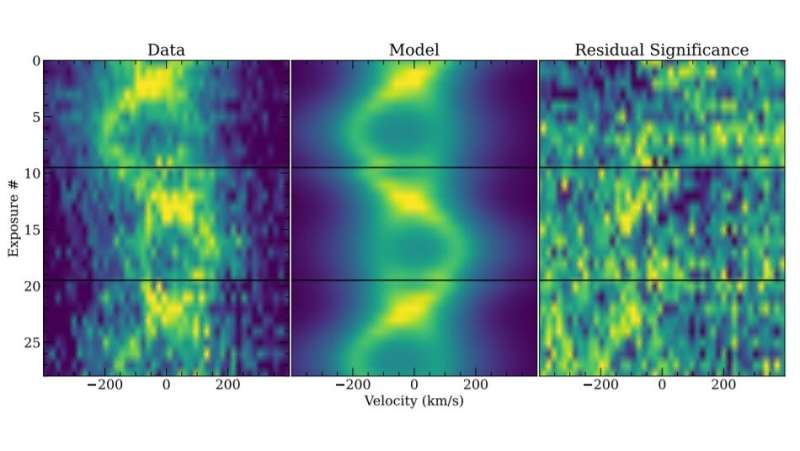Continuum-normalized Balmer Hα spectra of SDSS J1337+3952 from Gemini GMOS across three runs, separated by black lines, along with the double-lined binary model. Credit: Chandra et al., 2021.
An international team of astronomers has detected a new peculiar binary as part of the Sloan Digital Sky Survey (SDSS). The newly found object, designated SDSS J133725.26+395237.7, is a nearby double-lined system consisting of two white dwarfs. The finding is reported in a paper published August 26 on the arXiv pre-print server.
Astronomers are interested in finding and studying double white dwarfs (DWDs), as their mergers are believed to produce new white dwarfs with higher masses. It is assumed that some high-mass white dwarfs in the solar neighborhood could be DWD merger products.
So far, the majority of binaries, including DWDs, have been detected by Doppler shifts in their spectral lines; hence, these systems are called spectroscopic binaries. Observations show that in some spectroscopic binaries, spectral lines from both stars are visible, and these lines are alternately double and single. These systems are known as double-lined spectroscopic binaries (SB2).
The number of known SB2 white dwarf systems with well-measured mass and orbital parameters is still relatively small. Finding new objects of this type could be crucial in order to advance our knowledge about double white dwarfs in general.
Now, a team of astronomers led by Vedant Chandra of Johns Hopkins University in Baltimore, Maryland, reports the finding of a new addition to the short list of double-lined WDs. They identified SDSS J133725.26+395237.7 (or SDSS J1337+3952 for short) in the early data from the fifth generation Sloan Digital Sky Survey (SDSS-V). Data from the Gemini North Multi-Object Spectrograph (GMOS-N) and NASA's Swift spacecraft allowed them to determine fundamental parameters of the system.
"We identified SDSS J1337+3952 during a systematic search for RV [radial velocity] variable systems in the first year of SDSS-V," the researchers wrote in the paper.
According to the study, SDSS J1337+3952 is double-lined WD binary with a 99-minute orbital period, located some 368 light years away. The primary WD is about half as massive as the sun, but its radius is only 0.0141 solar radii. The secondary WD in the system has a mass of approximately 0.32 solar masses, while its radius is estimated to be 0.02 solar radii.
The cooling ages for the primary and secondary WDs were calculated to be 600 million and 1.2 billion years, respectively. Given that the low-mass secondary has a larger cooling age, the astronomers suppose that the present-day secondary was initially the more massive star, and it ascended the giant branch first and stably lost mass to its companion.
The researchers emphasized that due to its proximity to Earth and short period, SDSS J1337+3952 is among the strongest known sources of gravitational waves in the millihertz frequency regime. This gravitational wave emission will most likely cause the shrink down of the system's orbit to the point of interaction in about 220 million years from now. The authors of the paper assume that SDSS J1337+3952 will probably merge to form a rapidly rotating helium star which will end its life as a helium-atmosphere white dwarf.
More information: Vedant Chandra et al, A 99-minute Double-lined White Dwarf Binary from SDSS-V, arXiv:2108.11968 [astro-ph.SR] arxiv.org/abs/2108.11968
© 2021 Science X Network
























